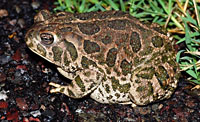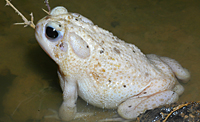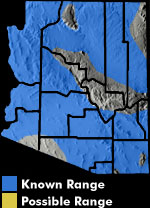Online Field Guide to The Reptiles and Amphibians of Arizona


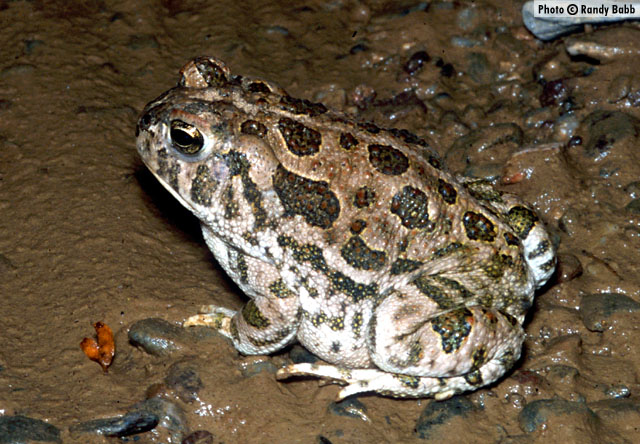
Pima County, AZ
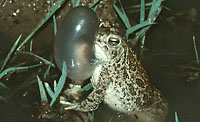 Cochise Co., AZ |
| GREAT PLAINS TOAD Anaxyrus cognatus | |
|
DESCRIPTION: Adult Great Plains toads measure about 2.2 – 5.0 inches in length. Females average a slightly larger size than males. The cranial crests atop the head are prominent and join at the snout to form a large, bony boss. The left and right crests diverge posteriorly from the boss to form a “V” between the eyes. Dorsal coloration varies from gray, tan, olive, to yellowish-brown. Pale-bordered, dark dorsal blotches are usually in symmetrical pairs and often separated by a light mid-dorsal stripe, which may be faint or absent. The venter is white or cream, and normally unspotted. Male Great Plains toads have a light colored throat-flap covering the black vocal sac. The inflated vocal sac is distinctly sausage-shaped. Juvenile toads have numerous small brick-red tubercles. Tadpoles grow to about one inch, are dorsally black or dark gray, and have a highly arched tail fin. The dorsal color lightens and becomes patterned in tadpoles nearing metamorphosis. DISTRIBUTION: The Great Plains toad is widespread in the Plains states and the Southwestern U.S., but also in portions of northern Mexico. In Arizona, the species is widespread, except for the higher mountains and lowest and driest portions of the Sonoran Desert. HABITAT: In Arizona, this species is found primarily in valleys, mesas, and flats characterized by Sonoran, Chihuahuan, or Great Basin desertscrub; grasslands; and sparingly into montane woodlands. Within these communities, Great Plains toads can often be found in cattle tanks, roadside ditches and canals in agricultural areas, in the floodplains of river and streams, ciénegas, and other wetland types. Except for the Colorado and Gila rivers and associated agriculture, the species is all but absent from the Colorado Subdivision of Sonoran Desertscrub. BEHAVIOR: This largely nocturnal toad is an accomplished burrower, emerging around dusk to forage or breed. Metamorph toads may be active by day, as well. In the lowlands, they emerge from dormancy in February or March and stay active at least through September. Activity periods are shorter at higher elevations. Great Plains toads can store up to 30% of their body weight in water, which provides a significant buffer against desiccation. REPRODUCTION AND CALLS: Breeding occurs in the spring, but also during the summer monsoon period. Breeding is often triggered by rainfall, but in croplands or along rivers and other permanent waters, spring breeding may occur in the absence of rainfall. Breeding can occur in either permanent or ephemeral waters, such as rain pools. The latter are preferred for breeding in eastern Arizona. Males congregate at breeding ponds and attract females with an often deafening chorus of long, high-pitched trills that individually can last up to 50 seconds. Eggs are laid in strings and number 1,300-45,000 per clutch. Hatching occurs in 2-7 days, and metamorphosis begins 17-45 days after hatching. In Arizona, sexual maturity is reached in two years post metamorphosis. Reproduction may not occur in years with insufficient rainfall, but females can produce multiple egg clutches in wet years. DIET: This toad feeds opportunistically on a variety of invertebrates. In the San Simon Valley, Cochise County, the predominant food items were ants and termites. REMARKS: Woodhouse’s toads appear to be displacing Great Plains toads on the lower Colorado River and perhaps in the croplands west of Phoenix. No subspecies of Anaxyrus cognatus are currently recognized. By Ernest Nigro and Jim Rorabaugh Brennan, T.C., & Holycross, A.T. 2006. A Field Guide to the Amphibians and Reptiles in Arizona. Arizona Game and Fish Department. Phoenix, AZ. Degenhardt, W.G., C.W. Painter, and A.H. Price. 1996. Amphibians and Reptiles of New Mexico. University of New Mexico Press, Albuquerque. Flowers, M.A. and B.M. Graves. 1995. Prey selectivity and size-specific diet changes in Bufo cognatus and B. woodhousii during early postmetamorphic ontogeny. Journal of Herpetology. 29 (4):608-612. Gergus, E.W.A., K.B. Malmos and B.K. Sullivan. 1999. Natural hybridization among distantly related toads (Bufo alvarius, Bufo cognatus, Bufo woodhousii) in central Arizona. Copeia. 1999 (2):281-286. Graves, B.M., and J.J. Krupa. 2005. Bufo cognatus Say, 1823 Great Plains Toad. Pages 401-404 in M.J. Lannoo (ed), Amphibian Declines: The Conservation Status of United States Species. University of California Press, Berkeley, CA. Krupa, J. J. 1990. Bufo cognatus. Catalogue of American Amphibians and Reptiles. (457):1-8. |
|
Visit Partners in Amphibian and Reptile Conservation:


HOME
Copyright © 2023, Arizona Game and Fish Department. All rights reserved.
If you make use of the textual contents of this site in reports, publications, etc. please cite and credit the author(s) and photographer(s). All photos on this website are copyrighted. However, those found in the species account section may be used for any noncommercial scientific, educational, or conservation purposes provided that photographs are not altered and continue to bear the copyright symbol and name of the photographer. Please contact the photographer regarding commercial use of copyrighted photographs.










